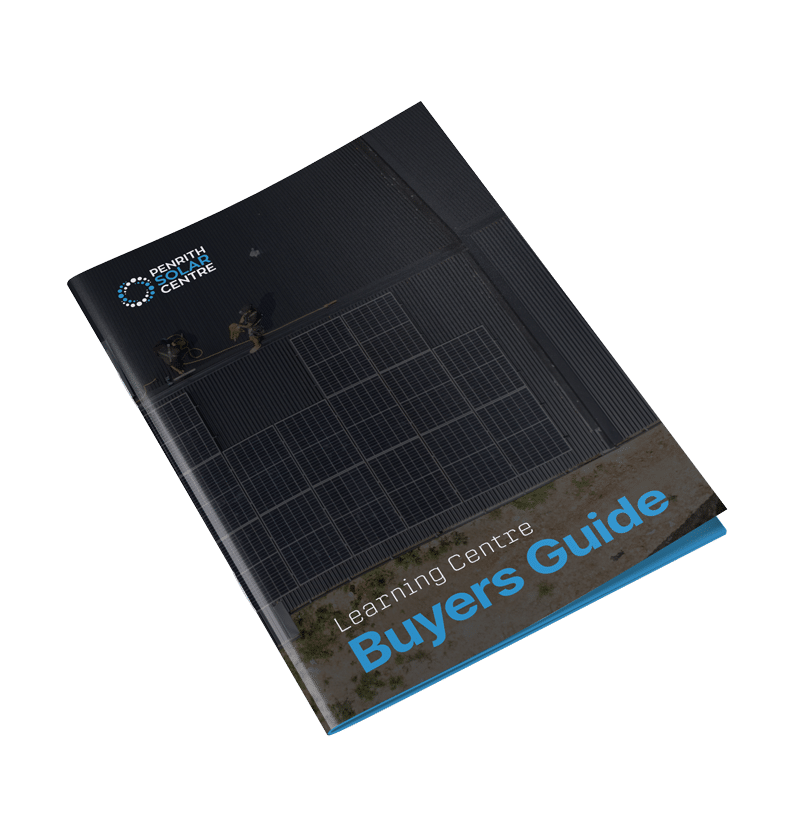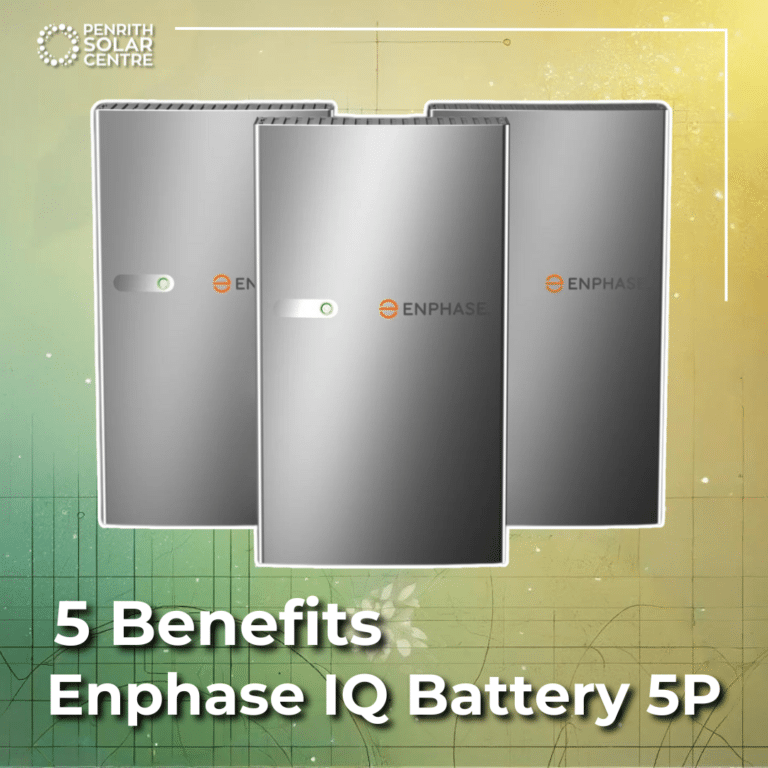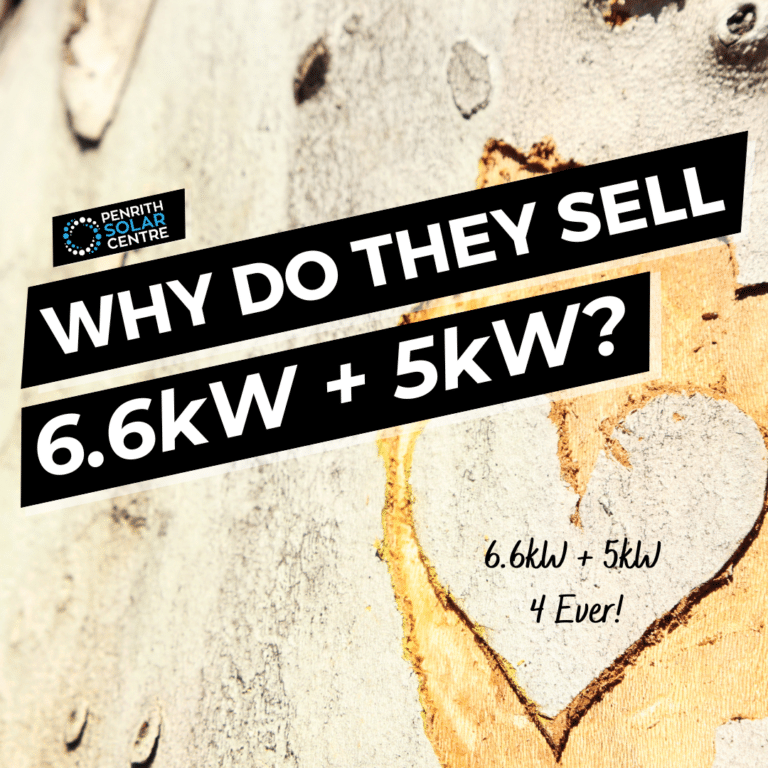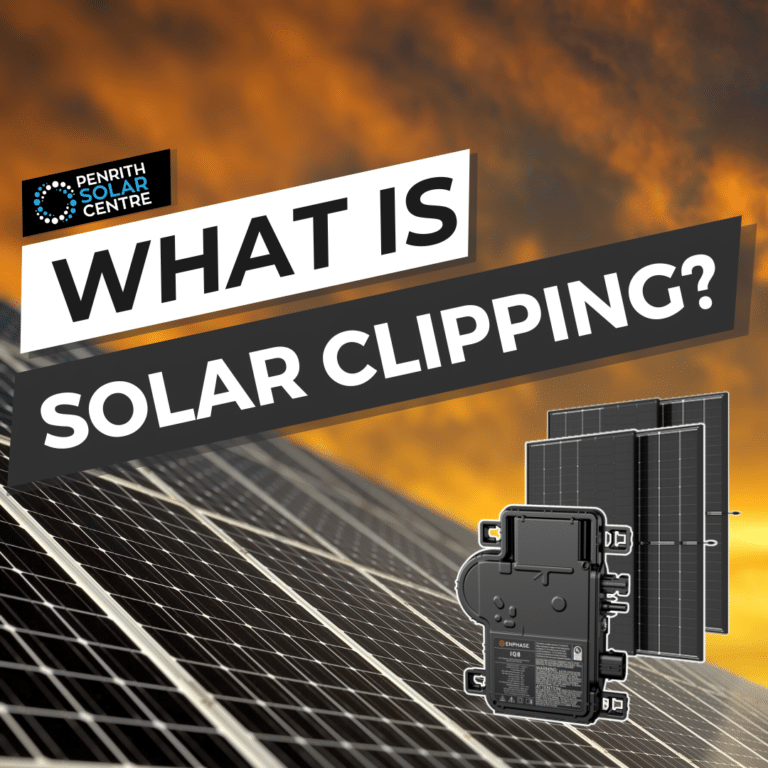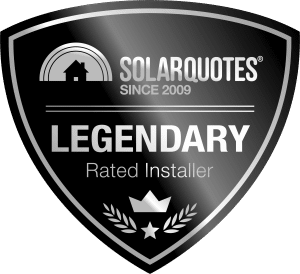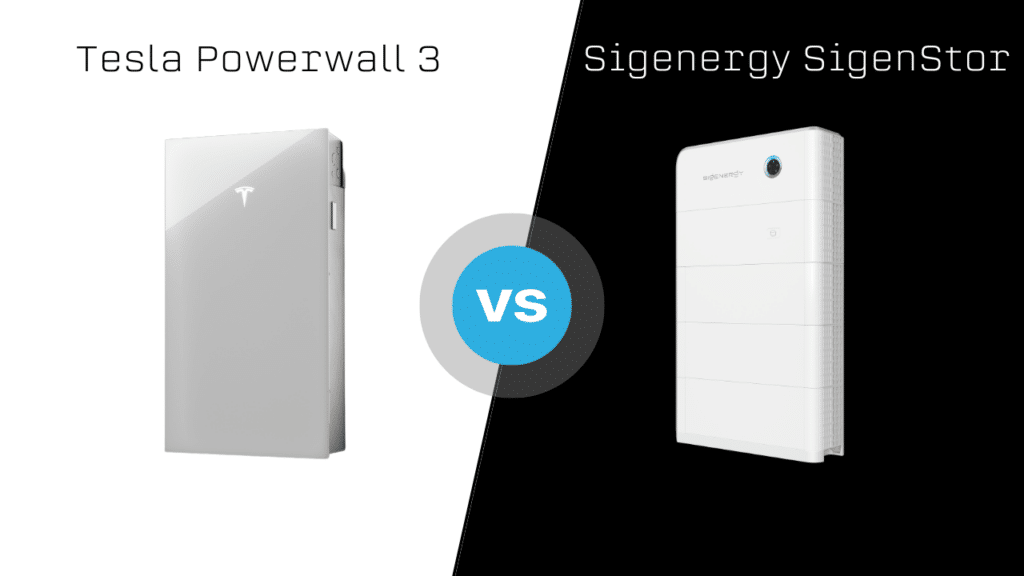
If you’re considering solar battery storage for your home, you’ve likely come across two major contenders: Tesla’s Powerwall 3 and the Sigenergy SigenStor.
Both systems combine battery storage and an inverter to help homeowners store and use solar energy more efficiently. But which one will work best for you?
At PSC, we install the Sigenergy SigenStor and the Tesla Powerwall 3. Each system has pros and cons; we’re here to dive into them for you.
In this article, you will learn the following:
- Powerwall vs. SigenStor: Understanding the Basics
- Powerwall vs. SigenStor: Energy Efficiency and Conversion Losses
- Powerwall vs. SigenStor: Backup Power and Blackout Protection
- Powerwall vs. SigenStor: Battery Capacity and Scalability
- Powerwall vs. SigenStor: Cost and Long-Term Value
- Powerwall vs. SigenStor: Real-World Usability and Integration
- Powerwall vs. SigenStor: Comparison Chart
By the end of this article, you’ll understand the differences between these two solar battery systems, even if you’re new to solar energy.
Powerwall vs. SigenStor: Understanding the Basics
Powerwall and SigenStor are similar in a lot of ways. Let’s dive into the basics.
Both Powerwall 3 and SigenStor have a hybrid inverter and battery storage. This two-in-one approach saves on components and installation time, but there’s more to each of them.
If you’re new to solar, you might be asking what a hybrid inverter is.
Think of your inverter as a translator.
The inverter in each energy system transforms the electricity harvested from the solar panels. That power comes in the form of direct current (DC) electricity. But your home runs on alternating current (AC) electricity.
The inverter makes that transformation possible. It makes your solar power usable in the home.
Both systems feature battery storage with an enclosed inverter if it’s a Powerwall and stackable modules if it’s SigenStor. The battery design in this system stores excess electricity generated by your solar panels.
You can use this stored energy later, such as at nighttime, when energy rates cost more, or during a power outage.
Now that we have the basics out of the way let’s get into an overview of each system:
Powerwall 3 Overview
- Fixed storage capacity of 13.5kWh.
- Built-in hybrid inverter, meaning it can convert electricity for both battery charging and home use.
- Designed to work best in Tesla’s ecosystem but can also be integrated with non-Tesla solar systems.
- Best suited for single-phase homes, with limited support for three-phase setups.
SigenStor Overview
- Modular design with a battery capacity of 8kWh increments, expandable up to 48kWh. There’s no limit to how many 48kWh stacks you can combine.
- Think of the SigenStor like Lego building blocks. Each block of 8kWh stacks up under the hybrid inverter block.
- Available in both single-phase and three-phase configurations, making it more flexible.
- Offers full three-phase backup, making it ideal for homes with large appliances that require balanced power distribution.
If you’re interested in learning a bit more about inverters, you might want to check out the following article titled, What is a Solar Power Inverter?
Powerwall vs. SigenStor: Energy Efficiency and Conversion Losses
Energy efficiency is one of the most important factors in a home battery system. Some energy is lost as heat whenever electricity is converted from one form to another through an inverter. We’ll get into that shortly.
You can install each energy system as either AC-coupled or DC-coupled. If you don’t want to get too technical, don’t worry. We’ll simplify it a bit for you.
Understanding AC and DC Coupling
DC coupling means solar panels send electricity directly to the battery in DC form before being converted into AC for home use. Both systems, when DC-coupled, have direct inputs from the solar system on the roof, so energy loss is minimised. They each have around 98% efficiency when installed this way.
Once energy is needed from the battery or directly from the panels on the roof, the energy is converted back to AC electricity. It’s a minimal conversion loss.
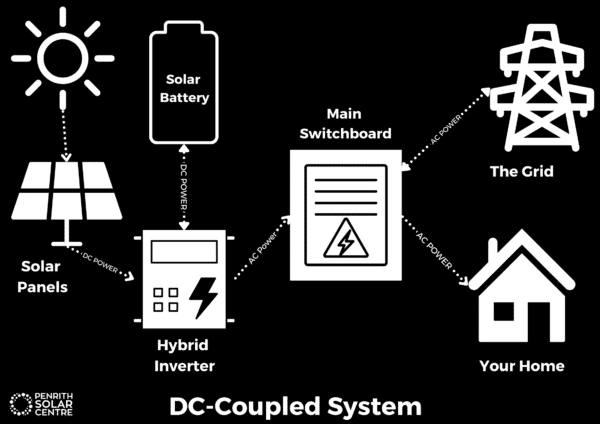
AC coupling means solar panels send DC electricity to the hybrid inverter. The hybrid inverter converts the DC power to AC power, which is what the home uses. The power is sent to the home. Leftover power goes to the battery.
However, batteries only store energy in DC form. It’s how batteries work; there’s a positive end, a negative end, and a direct current between them. So, the AC electricity must be converted again into DC power for storage.
And if the home needs power again, that electricity once again needs to be converted back to AC electricity for the home to use.
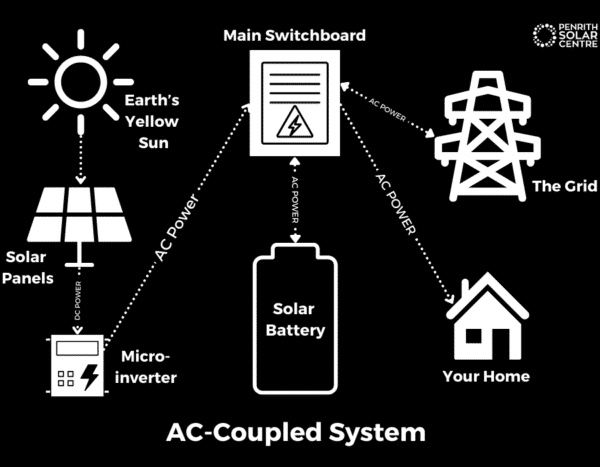
Every time electricity changes from DC to AC, energy is lost, reducing efficiency.
For batteries in their class, AC-coupled round-trip efficiency is usually around 90%.
Powerwall 3 Efficiency
- Powerwall 3 uses DC coupling when installed with a new solar system, which keeps efficiency high. The direct-from solar efficiency is 97.5%.
SigenStor Efficiency
- In a DC-coupled setup, it has an estimated 98% round-trip efficiency, slightly higher than Powerwall 3.
While the efficiencies are similar, SigenStor is slightly more efficient and the winner in this comparison.
If you’re interested in learning about types of solar batteries, you might want to check out the following article titled, AC-coupled Battery vs. DC-coupled Solar Batteries.
Ready to go solar? Click here.
Powerwall vs. SigenStor: Backup Power and Blackout Protection
If maintaining power during a blackout is your priority, understanding how these battery systems provide backup power is crucial.
Some systems offer whole-home backup, while others are limited to only critical circuits, impacting how much of your home remains powered.
Powerwall 3 Backup Power
- Designed primarily for single-phase homes.
- If installed in a three-phase home, it can only back up one of the three phases.
- If installed on a three-phase home, the phases will remain unbalanced and require additional inverters at an additional cost.
SigenStor Backup Power
- Available in single-phase or three-phase configurations.
- Full three-phase backup, meaning it can keep all circuits running during an outage.
- Can integrate with generators, making it useful for homes that experience frequent blackouts.
If you have a three-phase home and need full backup power, SigenStor is the better option.
If you’re interested in learning a bit more about the battery market, you might want to check out the following article titled, Best Home Solar Batteries for 2025.
Powerwall vs. SigenStor: Battery Capacity and Scalability
How much battery storage do you need? Well, that depends on how much energy your home uses and your future plans. If you’ve got a lot of appliances running or want to keep the lights on during a blackout, you might need a bigger battery.
And if you’re considering adding more solar panels down the track, it’s worth considering a system that can grow with you. Let’s dive into how to figure out the correct battery size for your home.
Powerwall 3 Storage Capacity
- Fixed at 13.5 kWh.
- You can install multiple Powerwalls. The separate units are combined in 13.5kWh increments.
- Currently, four can be stacked together for a total of 54kWh. Soon, in 2025, Tesla will release “dummy” Powerwalls, which are just the battery without the inverter. They’ve said that you’ll be able to stack up to 16 together for a whopping total of 216kWh.
SigenStor Storage Capacity
- Modular means you can start with 5 kWh/8kWh and expand to 48 kWh. They’re like Lego toy blocks. At PSC, we only carry the 8kWh version of the battery blocks. We feel that 5kWh isn’t enough to reap a solar battery’s potential. It will struggle to keep up with most systems.
- Each stack of six batteries (48kWh) can be stacked with an unlimited number of others to scale up for commercial installations.
- Works well for homeowners who want to start small and increase storage over time.
If you want flexibility in storage size and the ability to add more storage later easily, SigenStor is the better option.
If you’re interested in learning a bit more about solar batteries, you might want to start with the following article titled, Adding a Battery to a Solar System.
Power up your savings. Click here.
Powerwall vs. SigenStor: Cost and Long-Term Value
The upfront cost of a battery system is definitely something to think about, but what really matters is the long-term value it brings to your home.
Investing in a high-quality system means lower energy bills, better reliability, and fewer headaches down the track.
If it doesn’t last as long, perform well, or come with solid warranty support, you might pay more in the long run.
The following pricing includes installation.
Powerwall 3 Pricing
- Battery + Backup Gateway: $13,600.
- Installed cost: $15,990 for a retrofit, $23,990 with new solar.
SigenStor Pricing
- Starts at $9,990 for an 8kWh system.
- Total cost of the energy system varies based on battery size, inverter capacity, and whether your home is single-phase or three-phase.
- Can be cheaper or more expensive than Powerwall 3, depending on how much storage you need.
Both systems qualify for solar battery rebates, which can help lower costs.
However, the rebate is capped at 28kWh, which means you would be limited to two Powerwalls (27kWh) or three SigenStors (24kWh).
You can expect around $2,000 off Powerwall with the battery rebate per 13.5kWh unit.
You can expect around $1,100 off SigenStor with the battery rebate per 8kWh unit.
The battery rebate’s value changes slightly from day to day because of how the scheme is set up.
It’s complicated, but if you want to learn a bit more about it, you might want to check out the following article titled, Everything You Need to Know About the Home Battery Rebate for NSW.
Powerwall vs. SigenStor: Real-World Usability and Integration
When choosing a battery system, it’s not just about specs on paper; it’s also about how well it will fit into your daily life.
A good battery should seamlessly integrate with your solar system, adapt to your energy needs, and provide reliable backup when you need it most.
Powerwall 3 Integration
- Works best in Tesla’s ecosystem but can integrate with other solar systems.
- AC-coupling means it works with Enphase microinverters or a string system, though there are efficiency trade-offs.
SigenStor Integration
- Works with Enphase, string inverters, and hybrid setups when AC-coupled.
- Supports off-grid installations, unlike Powerwall 3. When combined with solar panels, the entire system can function independently of the grid.
If you’d like to learn a bit more about SigenStor, we recommend you check out the following article titled, Sigenergy SigenStor Review.
Let’s talk solar savings. Click here.
Powerwall vs. SigenStor: Comparison Chart
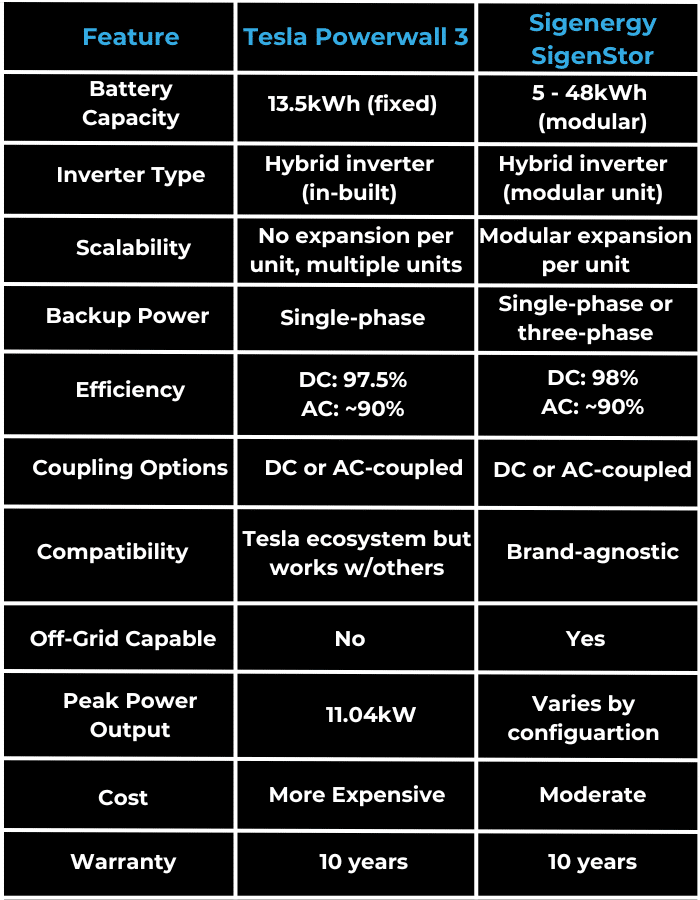
Get started with solar by clicking here.
Powerwall vs. SigenStor: Final Considerations
Powerwall 3
- Fixed storage capacity of 13.5kWh.
- Designed to work best in Tesla’s ecosystem but can also be integrated with non-Tesla solar systems.
- Best suited for single-phase homes, with limited support for three-phase setups and can only back up a single phase.
SigenStor
- Modular design with a starting capacity of 8kWh, expandable up to 48kWh per stack of six.
- Available in both single-phase and three-phase configurations, making it more flexible.
- Offers full three-phase backup, making it ideal for homes with large appliances that require balanced power distribution.
Powerwall 3 and SigenStor are strong home energy solutions but they serve different needs. Powerwall 3 is best for simple, all-in-one installations on single-phase homes, while SigenStor offers more flexibility, scalability, and backup power options for single or three-phase homes.
At PSC, we install both energy systems. When it comes to determining which system is right for you, we’re here to help. We customise solar systems every day to suit your unique energy needs and goals. It’s what we do.
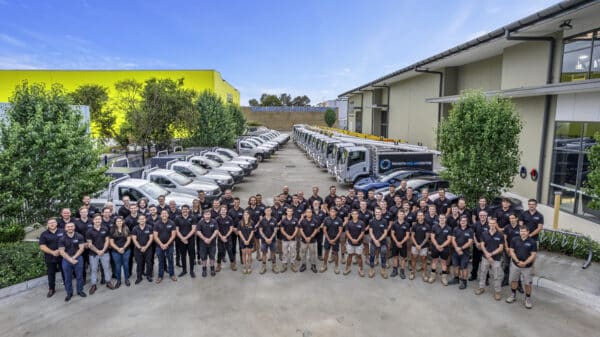
If you’d like to learn a bit more about the cost of SigenStor, we recommend you check out the following article titled, How Much Does the Sigenergy SigenStor Cost?
